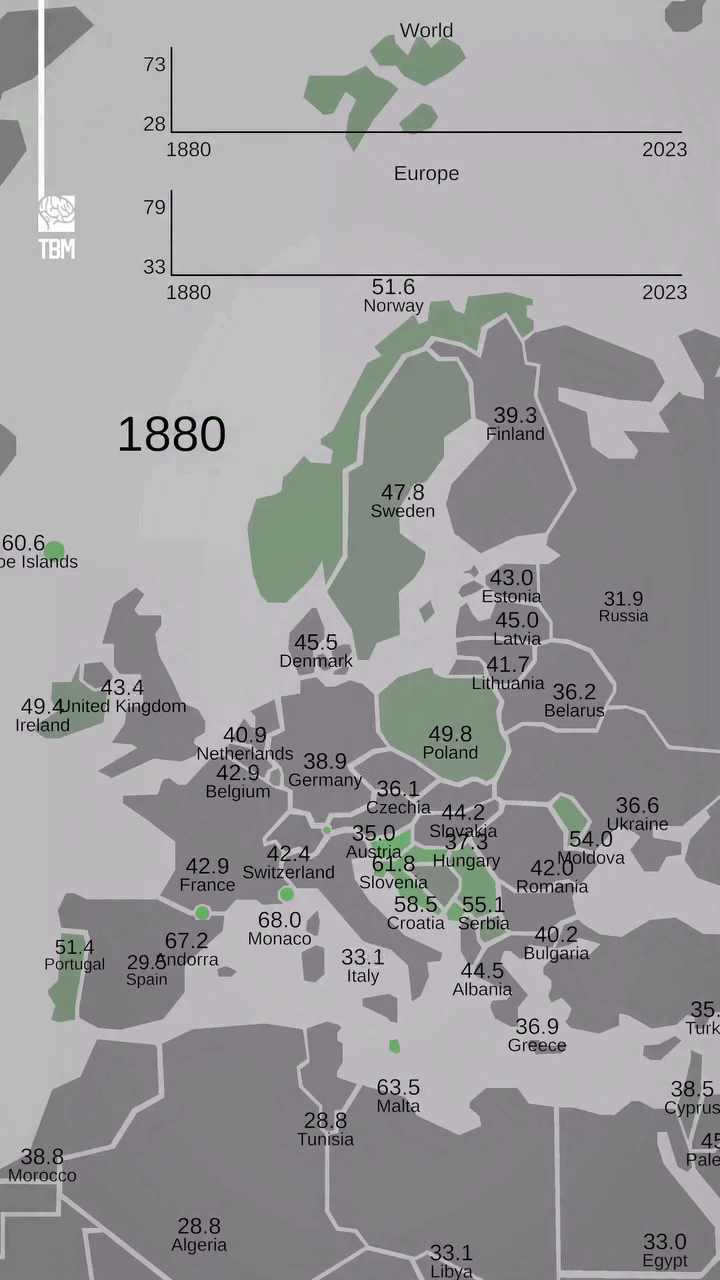Life Expectancy in Europe Map


Marcus Rodriguez
Historical Geography Expert
Marcus Rodriguez specializes in historical cartography and geographic data analysis. With a background in both history and geography, he brings unique...
Geographic Analysis
What This Map Shows
The "Life Expectancy in Europe Map" offers a visual representation of how life expectancy has evolved across different countries in Europe over the years. This map highlights significant trends, showcasing the disparities in life expectancy between nations and regions. As we dive into this topic, it becomes clear that understanding life expectancy is crucial for grasping the overall health and well-being of populations. Life expectancy is influenced by various factors, including healthcare access, lifestyle choices, and socio-economic conditions.
Deep Dive into Life Expectancy in Europe
Life expectancy is a vital statistic that reflects the average number of years a person can expect to live, given current mortality rates. In Europe, life expectancy has generally seen an upward trend over the past century, thanks to advances in medicine, improved healthcare systems, and better living conditions. However, this number varies significantly across the continent.
For instance, countries in Western Europe, such as Switzerland, Sweden, and Norway, boast some of the highest life expectancies in the world, often exceeding 82 years. Interestingly, this can be attributed to several factors, including universal healthcare systems, high standards of living, and strong public health initiatives. In contrast, Eastern European countries, like Ukraine and Russia, experience considerably lower life expectancies, sometimes dipping below 75 years. The reasons for these disparities often relate to historical context, economic challenges, and differing healthcare infrastructures.
Moreover, the impact of lifestyle choices cannot be overlooked. Countries with higher levels of physical activity, balanced diets, and low smoking rates tend to have longer life expectancies. For instance, Mediterranean nations such as Italy and Spain, where diets rich in fruits, vegetables, and healthy fats prevail, have shown excellent longevity rates. On the other hand, nations grappling with high rates of obesity and related health issues often see a negative impact on life expectancy.
Another vital aspect to consider is the role of social determinants of health, such as education, income, and employment stability. Countries that invest in education and provide social safety nets often report higher life expectancies. For example, the Nordic countries, known for their strong welfare systems, consistently rank at the top of life expectancy charts.
Regional Analysis
When analyzing the map regionally, we see clear distinctions. In Northern Europe, countries like Iceland and Norway lead with high life expectancies, largely due to their excellent healthcare systems, low crime rates, and high levels of education. The Scandinavian model of welfare has proven effective in securing lengthy and healthy lives for their populations.
Transitioning to Southern Europe, nations like Spain and Italy also report high life expectancies, attributed to their lifestyle choices and diets. However, disparities can arise within the region; for example, while urban areas may see longer life spans, rural regions can lag due to fewer healthcare resources.
In Eastern Europe, the situation becomes more complex. Countries like Poland and Hungary have been making strides in improving life expectancy, yet they still face challenges related to healthcare access and economic instability. Russia's lower life expectancy can be tied to historical factors, including the fallout from the Soviet era, which continues to impact healthcare and social systems today.
Western Europe remains the benchmark, with countries like France and Germany showcasing robust life expectancies. However, even within this region, there are variations, often influenced by regional health policies and socio-economic factors.
Significance and Impact
Understanding life expectancy is crucial not just for demographers, but for policymakers and public health officials. This statistic serves as a barometer for a country's health system and overall quality of life. Moreover, as Europe faces an aging population, the implications of life expectancy become even more pronounced. Countries with higher life expectancies will need to adapt to the challenges of an older population, including increased healthcare costs and the need for age-friendly environments.
Interestingly, current trends indicate that while life expectancy is generally improving, disparities remain persistent. Future projections suggest that countries must adapt their health policies to address these gaps, ensuring that advancements in healthcare and living conditions are universally accessible. The ongoing impact of global issues, such as the COVID-19 pandemic, also raises questions about future life expectancy trends, as health systems worldwide reevaluate their responses to such crises.
In summary, the "Life Expectancy in Europe Map" not only illustrates a vital statistic but also encourages a deeper understanding of the underlying factors influencing health across the continent. As we analyze this data, it becomes clear that striving for equitable health opportunities for all is essential for improving life expectancy in Europe.
Visualization Details
- Published
- October 13, 2025
- Views
- 18
Comments
Loading comments...